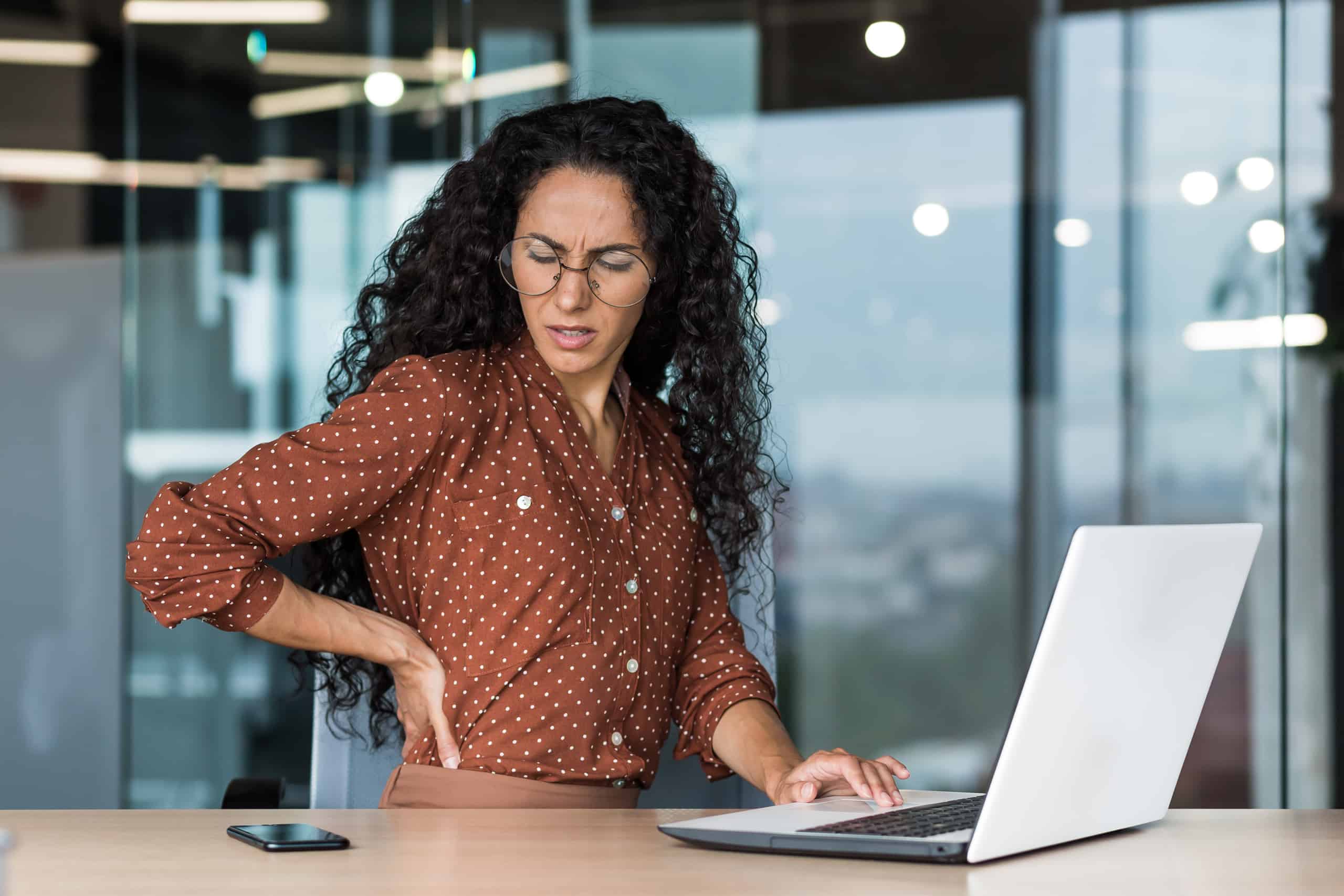Introduction
Eighty percent of working people may suffer from lower back pain due to poor posture. Desk and chair ergonomics can help alleviate this. This article looks into the relationship between desk ergonomics and lower back pain. We will also discuss tips on setting up a desk to reduce the risks.
Definition of Desk Ergonomics
Desk ergonomics is the practice of organizing and configuring an office space. This helps to maximize efficiency and comfort without increasing injury risk. It involves things like a suitable desk height, chair adjustability and putting the keyboard at a comfortable distance. The goal is to reduce neck or back strain, and promote better posture. Lower back pain can be reduced.
Recently, desk ergonomics has become more important. Remote working has increased, so employees don’t have access to ergonomic furniture. They have to rely on makeshift arrangements. But comfort and health don’t need to be sacrificed. Small desk adaptations can make a big difference to physical comfort and mental wellbeing.
Causes of Lower Back Pain
Lower back pain is something people of all ages suffer from, especially office workers who often sit for long hours. Desk ergonomics can greatly affect the degree of lower back pain.
In this article, we will explore the causes of lower back pain. Plus, how desk ergonomics can help reduce it.
Poor Posture
Poor posture can cause lower back pain, and even begin in childhood. Sitting in an awkward or unnatural position for too long, due to bad habits or lack of exercise, can cause imbalances in muscles and connective tissues. Slouching or hunching while sitting at a desk are common causes of poor posture that lead to back pain.
When seated, it’s important to sit up straight with feet on the ground and legs at 90-degrees. Your hips should be in line with shoulders and arms bent at 90-degrees to the armrest, wrists neutral. An ergonomically designed chair is also essential, to support the spine curves and provide enough cushion.
Other causes of poor posture include:
- Lifting heavy objects incorrectly.
- Holding objects away from your body.
- Standing for too long without taking breaks.
- Doing repetitive activities like typing without the right support for arms and hands.
All these posture problems can add to lower back pain if not handled.
Repetitive Motion
Repetitive motion is a major cause of lower back pain. People with desk jobs often develop fatigue and tension in the lower back from sitting in an unsuitable office chair and not having good posture. Repetitive motions such as bending, twisting, or lifting can create tension in the lower back, increasing the risk of injury.
Good posture is essential and the chairheight should be adjusted for the best forward lean. Take stretch breaks throughout the day to relax any tension in the lower back from sitting or standing for long periods of time. Wearing comfortable shoes that give good support also helps to protect lower back muscles.
If you can, add standing tasks to your daily routine and alternate between seated and standing tasks. During seated tasks, perform stretches and maintain proper posture. Keep both feet on the floor, with shoulders square with hips, and arms close together when crossing legs. Do not remain still for too long; move periodically to keep the circulation going.
Sitting for Long Periods of Time
Sitting a lot can cause chronic lower back pain. Even if you have a good chair and posture, extended sitting can worsen existing back issues. If you sit for long periods, take regular breaks to stretch and move in the office. Stretch for at least 5 minutes when you stand up.
When at the computer all day, consider how your body position affects not just the lower back but the whole spine. Poor postural habits weaken core muscles, reduce blood circulation and can pinch nerves. Take stretch breaks regularly, even if you don’t feel discomfort.
When seated, feet should be flat on the floor. Hips should be slightly higher than knees, reducing stress on the lumbar region. Shoulders should be rolled back and down, away from ears. Arms should be bent at 90 degrees. This will keep tension out of neck area, improve keyboard access and productivity.
Desk Ergonomics and Lower Back Pain
Ergonomics is essential for curbing lower back pain. This is especially true if you’re sitting at a desk for a long time. Desk ergonomics is arranging your workspace so it’s comfortable and efficient. Knowing the link between desk ergonomics and lower back pain can make sure your workspace increases productivity and wellness.
Adjustable Chair
A adjustable chair holds the key to a good ergonomic workstation. It needs to support a neutral posture, with a seat height that allows feet to rest flat on the floor. The backrest should adjust to keep your lower back comfortably curved.
Your knees should be lower than your hips when sitting. Armrests with adjustable height and width provide extra lumbar support. A comfortable cushion is an added plus.
Breaks are also vital, to ensure proper blood flow and prevent fatigue.
Monitor Position
Having the right monitor position is essential for desk ergonomics. Place it in front of you, away from windows. Keep it at least 20 inches away from your eyes, with the top below eye level. This will help you view your screen without straining. You can adjust brightness, contrast, font size, and background colors to reduce eyestrain and fatigue.
Hold your arms comfortably by your sides while typing. If there’s no arm rests, adjust the chair height for proper posture and less stress on your arms and hands.
When sitting at a desk, adjust your seat so it supports your spine’s normal curves. Your thighs should be flat against the floor or chair cushion. Feet should face forward, not outward or inward. Use a footrest if needed. The back rest should support the lower back area, without slumping. Allow for comfortable movement when needed.
Keyboard and Mouse Position
Maintaining proper ergonomics is a great way to help lower back pain. You can do this by arranging the components of your workstation in the right way. Especially important is how you position your keyboard and mouse.
You should set it up in a way that typing, scrolling, clicking is comfortable and looks effortless. To do this:
- Position the keyboard so it’s close to you, but not too close.
- Keep it 5 inches away from furniture surfaces.
- Keep wrists in neutral position when typing, with forearms aligned.
- Keep keys level with elbows when typing.
- Use an ergonomic split keyboard if possible.
- Keep the mouse next to you. Don’t use an external pointing device if there is no arm rest.
- Keep wrists reasonably straight when using any pointing device. This will help prevent wrist fatigue.
Footrest
Footrests are great for people who spend most of their day sitting at a desk. They help maintain good posture, reduce lower back pain and provide support for the legs and feet. Plus, they keep energy levels up throughout the day by promoting blood flow.
For optimal ergonomics, get an adjustable, non-slip footrest. Adjustable height settings are great to suit different body types. When using the footrest, make sure it’s close enough so you don’t have to reach too far. The angle should also be adjusted to prevent excessive inward or outward rotation of the knees. If not, there might be muscular issues. Lastly, incorrect positioning or use may lead to slouching or unnatural curvature of the spine, reducing its effectiveness.
Conclusion
So, we get it. Desk ergonomics and lower back pain go hand in hand. Great ergonomics can ease the strain on your back. Result? Better health!
Take steps to stop your pain getting worse. Be proactive. It’s the key to a healthy future.
Benefits of Desk Ergonomics
Desk ergonomics is the practice of arranging your workspace to reduce physical fatigue, strain, and injury. Employers are seeing how useful they can be in promoting health and wellbeing. So, they’re becoming more common in offices globally.
Benefits of desk ergonomics can lessen lower back pain symptoms:
- Muscle tension decreases: If your workspace fits you correctly – chair height, desk depth and monitor placement – your body will stay in a good posture. This reduces unconscious muscle work, which can reduce pain.
- Better circulation: Sitting in a bad position restricts blood flow to the lumbar muscles. Improved circulation prevents aches from sitting for long periods.
- Less fatigue: Having an ergonomic workspace stops you from overworking your body. You can change positions often, which helps avoid discomfort for those with lower back pain. Little changes can make a big difference.
Desk ergonomics can’t cure medical conditions, but it can help lessen symptoms. You’ll be more comfortable when sitting at a desk for extended periods.
Frequently Asked Questions
Q: What is the connection between desk ergonomics and lower back pain?
A: Poor desk ergonomics can lead to lower back pain as it can cause incorrect posture and lack of support for the back.
Q: How can a person improve their desk ergonomics?
A: A person can improve their desk ergonomics by adjusting their chair height, positioning their monitor at eye level, having proper wrist support, and adjusting their keyboard and mouse position.
Q: How can a person prevent lower back pain from desk work?
A: A person can prevent lower back pain from desk work by taking breaks, doing exercises to stretch and strengthen their back, and regularly adjusting their posture.
Q: Can using a standing desk help prevent lower back pain?
A: Yes, using a standing desk can help prevent lower back pain as it promotes better posture and reduces the amount of time sitting in one position.
Q: Are there any long-term consequences of poor desk ergonomics?
A: Yes, poor desk ergonomics can lead to chronic lower back pain, which can affect a person’s daily life and productivity if left untreated.
Q: Would a back support cushion help prevent lower back pain?
A: A back support cushion can provide temporary relief, but it is important to address the root cause of the lower back pain by improving desk ergonomics and engaging in back-strengthening exercises.









